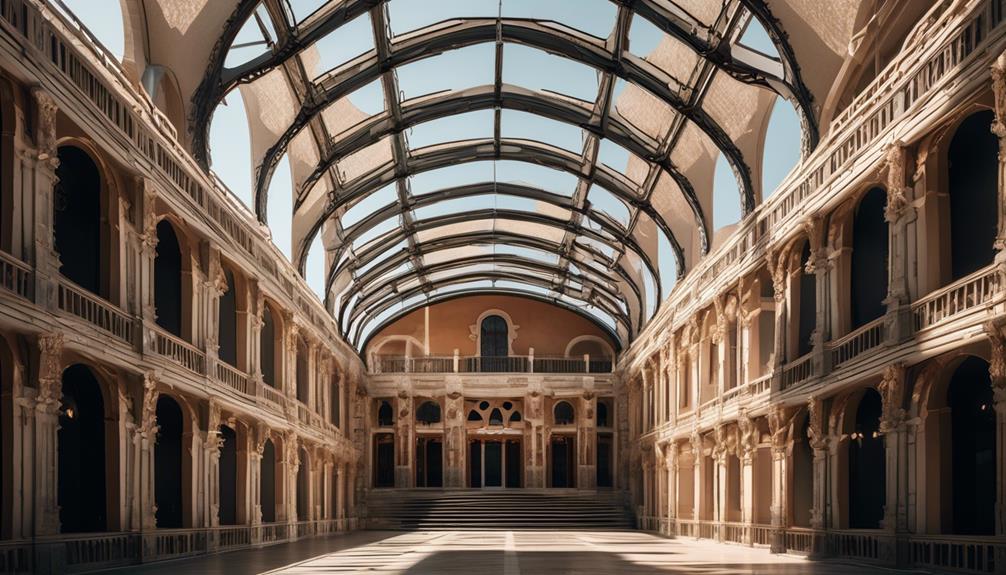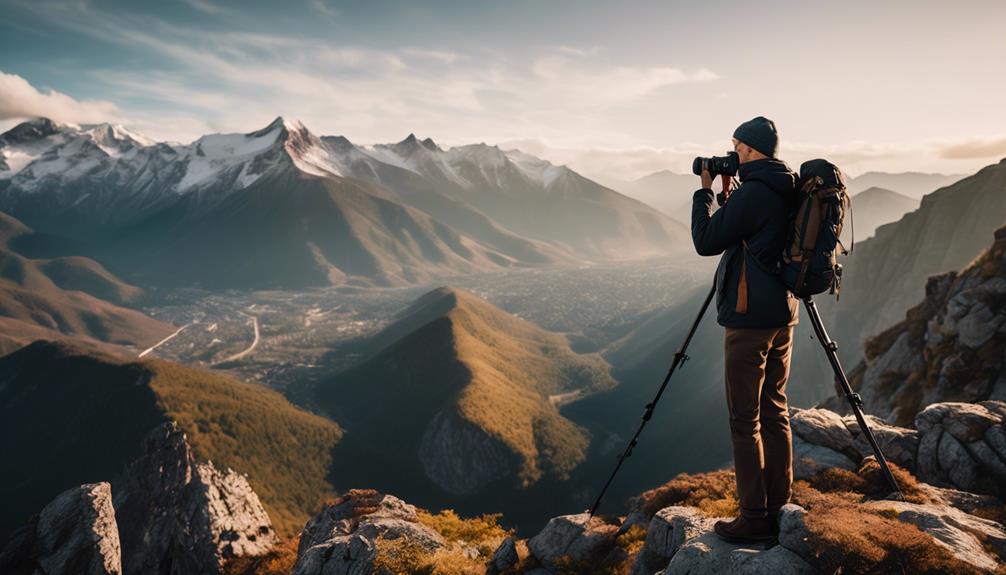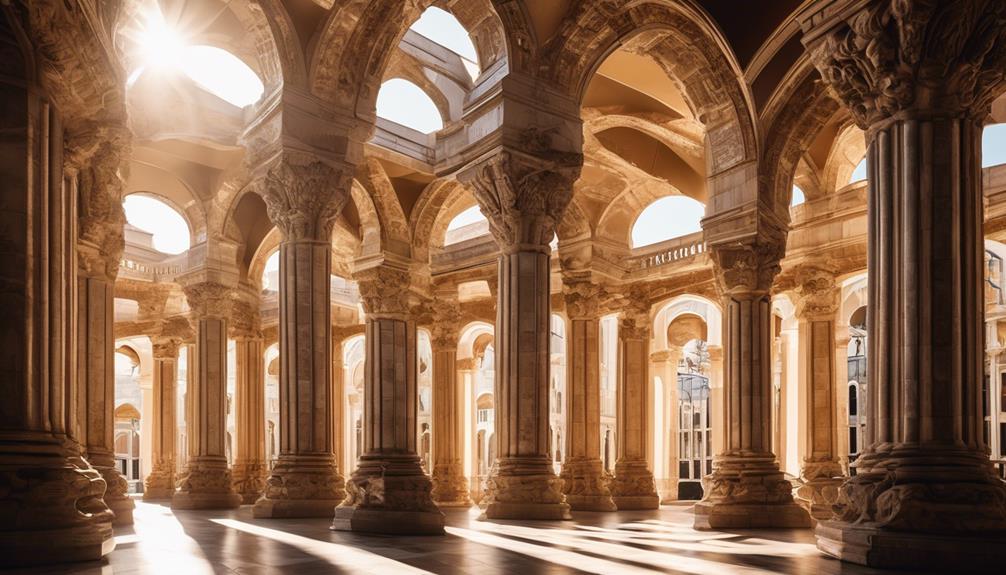Please note this post may contain affiliate links picked by me (Jay) that I have deemed may be of interest or relevant to you the reader of this.
These links do not affect the cost of the thing if you decide to purchase but i may get a little money if you choose to purchase.
For more information on my affiliate link policy click here.
As I stood before the magnificent structure, camera in hand, I couldn't help but feel a mixture of excitement and intimidation. Capturing the essence of architectural beauty seemed like a daunting task, but little did I know that there were five key principles that would unlock the secrets to taking incredible architectural photographs.
From mastering composition techniques to understanding lighting, choosing the right equipment, working with perspective, and honing post-processing techniques, each principle played a crucial role in transforming my photographs from ordinary to extraordinary.
But how exactly did these principles work their magic? Well, let's dive in and explore the fascinating world of architectural photography together.
Key Takeaways
- Composition techniques such as the rule of thirds, leading lines, symmetry, and creative angles are crucial in architectural photography.
- Lighting plays a vital role in capturing the mood and highlighting architectural details, and both natural and artificial lighting techniques should be explored.
- Choosing the right equipment, including essential lenses, tripods for stability, and lighting equipment, is important to achieve high-quality architectural photographs.
- Post-processing techniques, such as adjusting exposure and colors, straightening lines, enhancing textures, and using selective dodge and burn, can greatly enhance architectural photographs.
Composition Techniques
When it comes to capturing stunning architectural photographs, mastering composition techniques is essential. One of the most fundamental principles in architectural photography is the rule of thirds. This rule suggests dividing your frame into a 3×3 grid and placing your main subject along the lines or at the points where they intersect. By following this guideline, you can create a more visually interesting and balanced composition.
Another powerful composition technique in architectural photography is the use of leading lines. Leading lines are elements within the frame that naturally draw the viewer's eye towards the main subject. They can be found in the form of roads, pathways, or even the lines created by the architecture itself. By incorporating leading lines into your composition, you can create a sense of depth and guide the viewer's gaze towards the focal point of the image.
Symmetry is also a key element in architectural photography composition. Many architectural structures possess symmetrical features, such as perfectly aligned windows, doors, or columns. By centering your subject and aligning it with the symmetrical elements of the architecture, you can create a sense of balance and harmony in your photographs.
Mastering these composition techniques allows you to capture innovative and visually striking architectural photographs. By understanding the rule of thirds, utilizing leading lines, and incorporating symmetry, you can create images that aren't only aesthetically pleasing, but also convey a sense of innovation and creativity.
Understanding Lighting
Understanding lighting is crucial in architectural photography as it plays a vital role in capturing the mood, highlighting the details, and bringing the architectural elements to life. Whether it's natural or artificial lighting, knowing how to use light effectively can elevate the visual impact of your photographs.
In architectural photography, light is not just a tool to illuminate a space; it is a means to create atmosphere and accentuate the architectural details that make a building unique. By understanding the interplay between light and architecture, you can create visually stunning images that showcase the beauty and innovation of the design.
When it comes to lighting, there are two main types to consider: natural and artificial. Natural lighting refers to the use of sunlight, which can create a warm and inviting atmosphere, casting soft shadows that enhance the textures and shapes of the building. On the other hand, artificial lighting allows you to have more control over the lighting conditions, enabling you to highlight specific architectural details or create dramatic effects.
To effectively use light to highlight architectural details, it's important to consider the angle and direction of the light source. Placing the light at an angle can create depth and dimension, while directing the light towards a specific element can draw attention to it. Experimenting with different lighting techniques will help you discover the best way to showcase the unique features of each building.
| Lighting Technique | Description | Example |
|---|---|---|
| Side Lighting | Placing the light source to the side of the subject to create depth and shadows. | Photographing a building at sunrise or sunset to capture long shadows and emphasize the texture of the facade. |
| Backlighting | Positioning the light source behind the subject to create a silhouette effect. | Using the setting sun to backlight a building, creating a dramatic outline against the sky. |
| Accent Lighting | Using a focused light source to highlight a specific architectural detail or element. | Illuminating a unique feature, such as an intricate window or a decorative column, with a spotlight to make it stand out. |
| Ambient Lighting | Creating a balanced overall lighting in the space to capture the atmosphere and mood. | Photographing an interior with soft, diffused lighting to emphasize the warmth and coziness of the space. |
Understanding lighting is an essential skill for any architectural photographer. By harnessing the power of light, you can bring out the best in each building, capturing its essence and showcasing its unique architectural details in a visually striking way. So, whether you're working with natural or artificial lighting, remember to experiment, be creative, and let the light guide you in telling the story of each architectural masterpiece.
Choosing the Right Equipment
Now that we've explored the importance of understanding lighting in architectural photography, let's dive into the crucial aspect of choosing the right equipment to capture those stunning images.
As an architectural photographer, having the right tools is essential for achieving professional results. Here are three key pieces of equipment that every architectural photographer should have in their arsenal:
- Essential lenses: To capture the intricate details and wide perspectives of architectural structures, it's crucial to have a variety of lenses. A wide-angle lens, such as a 16-35mm, allows you to capture expansive views and emphasize the grandeur of a building. A tilt-shift lens is perfect for correcting perspective distortion and maintaining straight lines in your images. Lastly, a macro lens can help you capture intricate details and bring out the fine textures in architectural elements.
- Tripods and stability: Architectural photography often requires long exposures to capture the perfect shot. To avoid camera shake and ensure sharp images, a sturdy tripod is a must-have accessory. Look for a tripod that's lightweight yet stable, allowing you to easily adjust your camera's position and maintain stability during long exposures. Additionally, consider using a remote shutter release or the timer function on your camera to further minimize camera shake.
- Lighting equipment: While natural light can be beautiful for architectural photography, sometimes you'll need additional lighting to enhance certain areas or create a specific mood. A portable flash or strobe can help you add fill light and balance out any harsh shadows. Additionally, using reflectors or diffusers can help you control the direction and intensity of light.
Working With Perspective
Working with perspective is a fundamental skill that can elevate your architectural photography, allowing you to create visually captivating images that showcase the depth and scale of a building. By understanding how perspective works, you can manipulate it to your advantage and capture stunning photographs that truly capture the essence of the architecture.
One way to enhance your architectural photography is by experimenting with creative angles. Instead of just shooting straight on, try crouching down low or climbing up high to find unique perspectives. This can add a sense of drama and intrigue to your images, making them more visually interesting and dynamic.
Another important aspect of working with perspective is capturing depth. Architectural photography is all about conveying the three-dimensional nature of a building, and using perspective effectively can help achieve this. One technique is to include elements in the foreground, middle ground, and background of your composition. This creates layers and adds depth to the image, giving viewers a sense of space and dimension.
To summarize, working with perspective in architectural photography is essential for creating captivating images that showcase the depth and scale of a building. By experimenting with creative angles and capturing depth, you can elevate your photography to new heights and leave a lasting impression on your audience.
Mastering Post-Processing Techniques
Are you ready to take your architectural photography to the next level by mastering post-processing techniques? Post-processing plays a crucial role in enhancing the visual impact of your images and bringing out the true essence of the architectural structures you capture.
Here are three key techniques to help you elevate your post-processing skills:
- Contrast Enhancement: Adjusting the contrast in your images can make a world of difference. By increasing the difference between light and dark areas, you can create a more dynamic and impactful composition. Experiment with different contrast levels to find the perfect balance that enhances the architectural details while maintaining a natural look.
- Color Correction: Accurate color representation is essential in architectural photography. Use color correction techniques to ensure that the hues in your images accurately reflect the original scene. Adjusting the white balance, saturation, and hue can help you achieve a more vibrant and visually appealing result.
- Dodge and Burn: Dodging and burning is a powerful technique that allows you to selectively lighten or darken specific areas of your image. This technique helps to bring out the intricate details and textures of the architecture, creating a more three-dimensional and captivating photograph.
Frequently Asked Questions
Can Architectural Photography Be Done Using a Smartphone Camera?
Sure, architectural photography can definitely be done using a smartphone camera. However, it's important to consider the limitations of smartphone cameras, such as lower image quality and limited manual controls. To overcome these limitations, alternative equipment like wide-angle lenses or external tripods can be used.
With the advancements in smartphone camera technology, it's now possible to capture stunning architectural shots with just your phone. So, don't let the lack of traditional gear hold you back, embrace innovation and explore the possibilities of smartphone architectural photography.
How Can I Capture the Essence of a Building's History or Cultural Significance Through Architectural Photography?
To capture the essence of a building's history or cultural significance through architectural photography, it's essential to focus on capturing the intricate architectural details and paying attention to the importance of lighting.
By carefully selecting angles and emphasizing unique features, the true character and story of the building can be beautifully conveyed.
Lighting plays a crucial role in highlighting textures and creating depth, allowing the viewer to truly appreciate the architectural masterpiece.
It's through these techniques that the spirit of a building can be immortalized in photographs.
Are There Any Legal Considerations or Restrictions to Keep in Mind When Photographing Buildings or Architectural Landmarks?
When it comes to photographing buildings or architectural landmarks, there are definitely some legal considerations and restrictions to keep in mind. One of the main concerns is avoiding any potential copyright infringement.
It's important to remember that some buildings may be protected by copyright laws, especially if they're newer or have unique designs. Make sure to obtain permission from the appropriate authorities or property owners before capturing those iconic shots.
It's always better to be safe than sorry when it comes to legal restrictions in architectural photography.
What Are Some Effective Ways to Capture the Scale and Grandeur of Large Architectural Structures?
When it comes to capturing the scale and grandeur of large architectural structures, there are a few effective ways that I've found useful.
Firstly, capturing details is key. By focusing on specific elements, such as the intricate patterns or unique features, you can convey the magnitude of the structure.
Secondly, using lighting techniques can enhance the drama and depth of the photograph. By playing with shadows and highlights, you can create a sense of depth and emphasize the size of the architectural masterpiece.
How Can Architectural Photography Be Used to Convey a Specific Mood or Emotion?
When it comes to architectural photography, one of the most powerful tools we have is the ability to convey a specific mood or emotion. By carefully selecting lighting, angles, and composition, we can create images that transport viewers to another time or evoke a sense of nostalgia.
Whether it's capturing the ethereal beauty of a gothic cathedral or the sleek modernity of a skyscraper, architectural photography allows us to tell stories and elicit emotions through our images. It's a thrilling and innovative way to connect with an audience and push the boundaries of visual storytelling.
Conclusion
In conclusion, by following these 5 key principles in architectural photography, you'll be well on your way to capturing stunning images that truly bring buildings to life.
From mastering composition techniques to understanding lighting and choosing the right equipment, every step you take will lead you closer to becoming a true architectural photography maestro.
So grab your camera, embrace your passion, and let your creativity soar as you embark on this exciting journey into the world of architectural photography.
Happy shooting!


